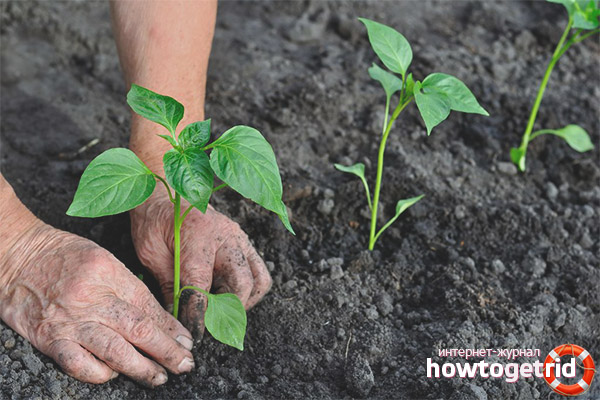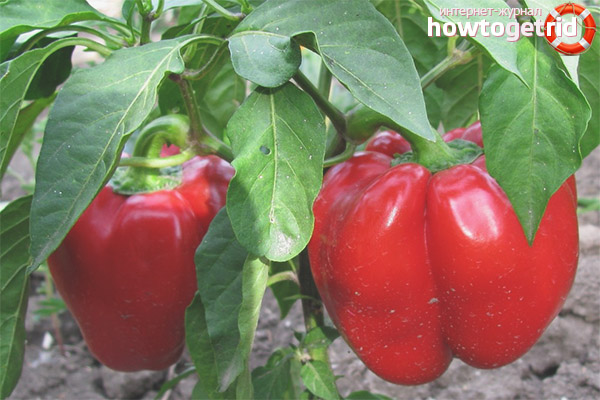The content of the article
Ratunda pepper has an unusual spherical, sometimes flattened shape, pleasant aroma, excellent taste and a high content of vitamins C and P. The wall thickness is from 6 to 10 mm, the color at the stage of biological maturity is bright red, the skin is smooth, shiny, sometimes with a matte coating. The plant is fruitful, gives up to 5 kg of fruits per season.
Grade Features
There are varieties with spherical or flattened fruits; in some varieties, ribbing is pronounced. In the seed chambers, a significant number of seeds ripen. Seeds can be harvested for sowing in subsequent years.
The bushes are low, stampede, up to 90 cm. Fruiting lasts until the first autumn frosts. The taste of pepper Rotunda at a height of the fruits is cooked lecho, canned whole, frozen. The fruits of Ratunda are used to decorate dishes.
Sowing seeds
An important point in the issue of planting seeds for seedlings is the preparation of a high-quality soil mixture. Bell pepper prefers acid-neutral soil, black soil or sandy loam soil. It is not recommended to use the land from the garden, it contains spores of pathogenic fungi, pests. You can prepare the soil mixture yourself from black soil, peat, sand and ash.
It is desirable to freeze or steam the soil in order to destroy weed seeds and pathogenic fungal spores.
Buy pepper seeds only from trusted sellers in seed stores. Before sowing, check the seed for germination, disinfect it and treat it with a growth stimulator.
Sow seeds at a distance of 2 cm from each other, with thickened plantings, young plants begin to compete for light, water and nutrients.
Seeding depth is 1-1.5 cm, do not deepen the seeds too deep, they simply will not germinate or they will not grow together amicably and inopportune. In the boxes there should be drainage from expanded clay, broken shards.
Cover the seeds with foil or glass to create a greenhouse effect. Water the crops once every 2-3 days by spraying from the sprayer. Protect young plants from drafts and sudden changes in temperature.
Do not allow waterlogging, due to excess moisture, the “black leg” disease may develop, plants will fade and die. Do not forget to regularly air the seedlings by lifting the film or glass for a couple of hours.
In the early days, sunlight is not needed, enough heat and moisture, but as soon as whitish loops of shoots of pepper appear, seedlings need to be moved closer to the light, for example, on the windowsill.
A common mistake of beginning gardeners is a rush with sowing seeds in January and February. People sow seeds as early as possible in the hope of getting an early harvest.
This is a mistake, because the daylight hours at the end of winter are very short, the weather is usually cloudy and slightly sunny. Plants are sorely lacking in sunlight. Without additional highlighting, the seedlings are elongated, frail, yellow, unviable. Such plants develop poorly after transplantation, take root for a long time, get sick, give few fruits.
If you still decided to sow pepper at the end of winter, be sure to take care of additional lighting, buy special lamps. Additional highlighting should be done in the morning and evening for 2-3 hours, no less.
The first fertilizing with nitrogen fertilizers is carried out three weeks after emergence.At the stage of three leaves, seedlings are picked with transplantation into separate containers. You can not grow seedlings in one pot without a dive. Plants will interfere with each other, will begin to compete for solar energy, water and trace elements. Seedlings will be high, frail, weakened. There will be no sense in such planting material, plants will hurt after transplantation, and will yield a very meager crop.
Planting pepper seedlings in greenhouses
If you plan to grow pepper in greenhouses, there is no need to temper seedlings. Young plants should not be planted until a stable, warm temperature is established.
When growing peppers in greenhouses, ventilation should be provided. The fact is that at a temperature of 35 degrees and above, the pollen of bell pepper becomes sterile, fertilization does not occur, and accordingly the fruits are not tied.
In general, when grown indoors, Rotunda pepper gives a better crop than outdoors. Do not forget to remove the stepsons, cut off the lower leaves in contact with the ground, conduct timely top dressing.
Planting pepper seedlings in open ground

You can plant pepper in the open ground at the end of May, when the threat of return frosts passes. Sweet pepper is a heat-loving culture that does not tolerate drafts and lower temperatures to 8 degrees. Even short-term temperature drops are detrimental to the southern plant.
In planting holes or furrows, you can add a handful of humus, a little wood ash, and pour plenty of warm water on the soil. When transplanting seedlings, be careful not to damage the root system, remove plants from pots with a lump of earth. Previously, the soil in pots needs to be watered so that seedlings are easily taken from the containers. The fact is that pepper roots grow very poorly, they are easily injured.
Immediately after planting, water the plants again under the root with warm water. Cover the plantations with covering material to protect them from scorching sunlight and wind.
It is recommended to immediately mulch the soil under young plants. Under the mulch layer, worms and insects are activated that help to loosen the soil, enriching it with oxygen. In addition, mulch will prevent the evaporation of moisture from the topsoil, prevent the growth of weeds, and reduce the required number of loosening.
Some gardeners recommend hilling pepper bushes. This culture is not watered frequently, about once every 3 days.
The first top dressing is performed a couple of weeks after transplanting seedlings. Nitrogen fertilizers are used, potash-phosphorus preparations are in the flowering stage.
Ratunda pepper is responsive to organic nutrition. You can personally prepare a wonderful preparation - herbal infusion. To do this, take nettle, dandelion leaves, mowed herbs and place them in a tank or barrel, then fill in the plant material with heated water, leave for fermentation for three weeks. After fermentation, the liquid is filtered, diluted with warm water, and pepper is watered under the root.
Pepper is a culture that does not tolerate waterlogging and stagnation of moisture; it is better to undersaturated than to overfill. In regions with a cold climate, it is recommended to grow in glazed greenhouses.
Video: Ratunda pepper










Submit